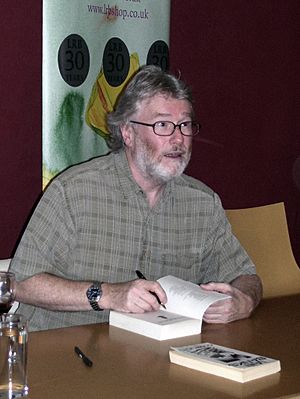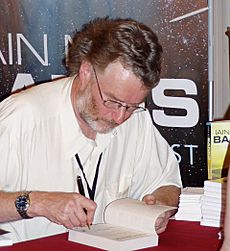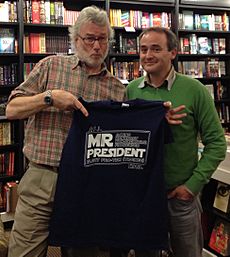Iain Banks facts for kids
Quick facts for kids
Iain Banks
|
|
|---|---|

At the Edinburgh International Book Festival, 2009
|
|
| Born | 16 February 1954 Dunfermline, Fife, Scotland |
| Died | 9 June 2013 (aged 59) Kirkcaldy, Fife, Scotland |
| Pen name | Iain M. Banks |
| Occupation | Writer |
| Education | University of Stirling (BA) |
| Period | 1984–2013 |
| Genre |
|
| Spouse |
Annie Blackburn
(m. 1992; div. 2007)Adele Hartley
(m. 2013) |
Iain Banks (born 16 February 1954 – died 9 June 2013) was a famous British author. He wrote different kinds of books. For his everyday stories, he used the name Iain Banks. For his science fiction books, he used Iain M. Banks. The "M" stood for Menzies, which was his middle name.
After his first book, The Wasp Factory, became very popular in 1984, he started writing full-time. His first science fiction book, Consider Phlebas, came out in 1987. This book began his well-known Culture series. Many of his books were turned into plays, radio shows, and TV series. In 2008, The Times newspaper called him one of the "50 greatest British writers since 1945."
In April 2013, Iain Banks shared sad news. He had a serious type of cancer that could not be cured. He passed away on 9 June 2013.
Contents
Early Life and Education
Iain Banks was born in Dunfermline, Fife, Scotland. His mother was a professional ice skater. His father was an officer in the Admiralty, which is like the navy. Iain was an only child.
He lived in North Queensferry until he was nine. This was close to the naval dockyards where his father worked. Later, his family moved to Gourock. A friend gave him a science fiction book, Kemlo and the Zones of Silence. This book made him love science fiction and inspired him to write his own stories.
After high school, Banks studied English, philosophy, and psychology at the University of Stirling. This was from 1972 to 1975.
After college, Banks took many different jobs. These jobs allowed him to write in the evenings. He worked as a clerk for IBM and a testing technician for a steel company. He also worked for a law firm. These jobs gave him time to travel around Europe and North America.
Writing Career
Iain Banks started writing when he was just 11 years old. He finished his first novel, The Hungarian Lift-Jet, at 16. His second novel, TTR, was written during his first year at Stirling University in 1972. Even though he loved science fiction, he first tried to publish everyday stories.
His first book to be published was The Wasp Factory in 1984. He was 30 years old at the time. After this book became a big success, Banks became a full-time writer. His editor suggested he write one book every year, and he agreed.
His next books included Walking on Glass (1985) and The Bridge (1986). In 1987, he published Espedair Street, which was later made into a radio series. That same year, his first science fiction book, Consider Phlebas, was published. This book started his famous Culture series. Banks said that writers like Robert A. Heinlein and Isaac Asimov influenced his science fiction.
His novel The Crow Road, published in 1992, was made into a BBC television series. Banks kept writing both science fiction and mainstream books. His last novel, The Quarry, came out in June 2013, the same month he passed away.
Why Two Names?
Banks published his books under two different names. His parents had planned to name him "Iain Menzies Banks." But his father accidentally registered him as "Iain Banks." Iain still used Menzies as his middle name.
When he sent The Wasp Factory to be published, he used "Iain M. Banks." His editor thought the "M" looked "too fussy." The editor also worried people might confuse him with a romantic novelist named Rosie M. Banks. So, Banks agreed to drop the "M" for his first few books.
After he wrote three mainstream novels, his publishers agreed to release his first science fiction book, Consider Phlebas. To help readers tell the difference between his mainstream and science fiction books, Banks suggested adding the "M" back for his science fiction work. From then on, all his science fiction books used the name Iain M. Banks.
By the time he died in June 2013, Banks had published 26 novels. A 27th novel, The Quarry, was published after his death. His last work, a collection of poems, came out in February 2015. He had also planned another book in his Culture series, which would have been published in 2014.
Banks wrote in many different styles, but he enjoyed writing science fiction the most. In September 2012, he was chosen as a special guest for the 2014 World Science Fiction Convention, called Loncon 3.
Media Appearances
Iain Banks was featured in a TV show called The Strange Worlds of Iain Banks in 1997. This show looked at his mainstream writing. He also appeared on radio shows, including Rocket Science on BBC Radio 6 Music. An audio version of his book The Business was broadcast on Galaxy FM in 1999.
His story The State of the Art was adapted for BBC Radio 4 in 2009. In 1998, his novel Espedair Street was made into a radio series for Radio 4.
In 2011, Banks was on the BBC Radio 4 program Saturday Live. He talked about his beliefs, explaining that death is a natural part of life.
Banks also appeared on the BBC television show Question Time, which discusses politics. In 2006, he led a team of writers to win a special series of University Challenge. He also won a 2006 episode of Celebrity Mastermind. His special topic was "Malt whisky and the distilleries of Scotland."
His last interview was with Kirsty Wark, shown on BBC2 Scotland in June 2013. In June 2015, BBC One Scotland and BBC2 showed a TV adaptation of his novel Stonemouth.
Theatre Work
Banks was involved in a play called The Curse of Iain Banks. This play was shown at the Edinburgh Festival Fringe in 1999. He often worked with the play's music composer, Gary Lloyd. They even wrote songs together as a tribute to a fictional band from Banks's novel Espedair Street.
Lloyd also created music for a spoken-word version of Banks's novel The Bridge. Banks himself provided the voice for this production, which was released on CD in 1996.
Political Views
Iain Banks was known for his "left of centre" political views. This means he generally supported ideas that aim for more equality and social justice. In 2002, he supported the Scottish Socialist Party.
He was also a supporter of groups that promote non-religious views, like the National Secular Society and the Humanist Society Scotland. He signed the Declaration of Calton Hill, which supported Scottish independence. This means he believed Scotland should be an independent country. In 2012, he said that the independence movement in Scotland was about people working together.
In 2004, Banks joined a group of people who wanted to question Prime Minister Tony Blair about the 2003 invasion of Iraq. To show his protest, Banks cut up his passport and mailed it to the Prime Minister's office. He explained that he was very concerned about the war. He wrote about his worries in his book Raw Spirit.
In 2010, Banks called for a cultural and educational boycott of Israel. This was after an incident involving ships trying to deliver aid to Gaza. He supported the Boycott, Divestment and Sanctions (BDS) campaign. This campaign asks for Israel to follow international law and respect Palestinian rights. Banks said he did not buy products from Israel and tried to support products from Palestine.
Personal Life
Iain Banks met his first wife, Annie, in London before his first book came out in 1984. They lived in Faversham in England. They separated in 1988, and Banks moved back to Edinburgh. A year later, Iain and Annie got back together and moved to Fife. They married in Hawaii in 1992 but separated again in 2007 after 15 years.
In 1998, Banks was in a serious car accident. In 2007, he sold his large collection of cars. This included several Porsches, a Jaguar, a BMW, and a Land Rover. He then bought a hybrid car and later a small diesel car. He also said he would only fly in emergencies to reduce his impact on the environment.
In April 2012, Banks was given a funny title by the Science Fiction Book Club in London. He became their "Acting Honorary Non-Executive Figurehead President Elect pro tem (trainee)." He even designed the title himself!
From 2007, Banks lived in North Queensferry with his girlfriend, Adele Hartley. She is also an author and started a film festival. They had been friends since the 1990s and started dating in 2006. They got married on 29 March 2013.
Illness and Death
On 3 April 2013, Iain Banks announced on his website that he had been diagnosed with terminal gallbladder cancer. This meant his cancer could not be cured, and he was not expected to live for more than a year. He said he would stop all public appearances. He also announced that The Quarry would be his last novel.
At his request, the publication dates for The Quarry were moved up. It was released in June 2013. Iain Banks passed away on 9 June 2013.
Remembrance and Tribute
Banks's publisher said he was "an irreplaceable part of the literary world." Other writers and friends also shared their sadness. Scottish author Ken MacLeod said Banks's death left a "large gap in the Scottish literary scene." Famous authors like Neil Gaiman and Ian Rankin also wrote tributes.
After his death, an asteroid was named 5099 Iainbanks in his honor. In 2015, SpaceX CEO Elon Musk named two of his company's special ships Just Read The Instructions and Of Course I Still Love You. These names came from ships in Banks's Culture novels. Another ship, A Shortfall of Gravitas, was started in 2018, also named after a ship in his books.
A graphic novel about Louise Michel, published in 2016, was dedicated to Iain Banks. It called him a "friend and sorely missed creator of socialist utopias." The seventh book in The Merchant Princes series by Charles Stross, published in 2017, was also dedicated to Banks.
In 2019, during the Five Deeps Expedition, a deep-sea submersible and its support ship were named after vessels from the Culture series. This showed how much explorer Victor Vescovo admired Banks's work.
Awards and Nominations
Iain Banks received many awards and nominations for his writing:
- 1988: British Science Fiction Association Award for The Player of Games (nomination)
- 1990: British Science Fiction Association Award for Use of Weapons (nomination)
- 1991: Arthur C. Clarke Award for Use of Weapons (nomination)
- 1991: Kurd-Laßwitz-Preis for Foreign Novel The Bridge (winner)
- 1992: Kurd-Laßwitz-Preis for Foreign Novel The Wasp Factory (winner)
- 1993: Kurd-Laßwitz-Preis for Foreign Novel Use of Weapons (winner)
- 1994: British Science Fiction Association Award for Feersum Endjinn (winner)
- 1994: Locus Poll Award for Against a Dark Background (nomination)
- 1996: British Science Fiction Association Award for Excession (winner)
- 1997: University of St Andrews honorary degree
- 1997: University of Stirling honorary doctorate
- 1997: British Fantasy Award for Excession (nomination)
- 1998: British Science Fiction Award for Inversions (nomination)
- 1998: Kurd-Laßwitz-Preis for Foreign Novel Excession (winner)
- 2001: Locus Poll Award for Look to Windward (nomination)
- 2004: Premio Italia Science Fiction Award in the Best International Novel category for Inversions (winner)
- 2005: Hugo Award for The Algebraist (nomination)
- 2005: Locus Poll Award for The Algebraist (nomination)
- 2009: Locus Poll Award for Matter (second place)
- 2009: Prometheus Award for Matter (nomination)
- 2010: Open University honorary doctorate
- 2010: John W. Campbell Memorial Award for Transition (finalist)
- 2010: Locus Poll Award for Transition (nomination)
- 2011: Locus Poll Award for Surface Detail (nomination)
- 2013: Honorary Fellow of the Association for Scottish Literary Studies
Images for kids
See also
 In Spanish: Iain Banks para niños
In Spanish: Iain Banks para niños




